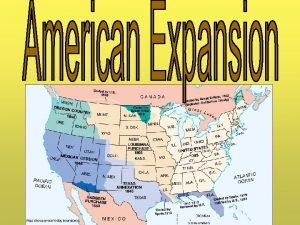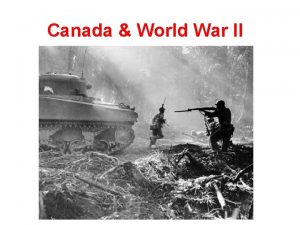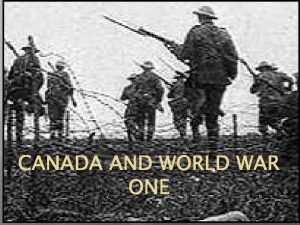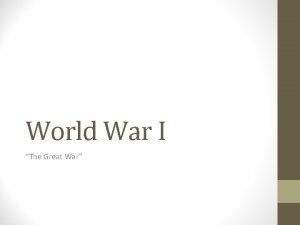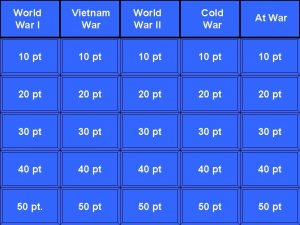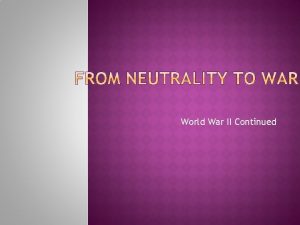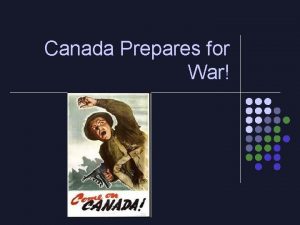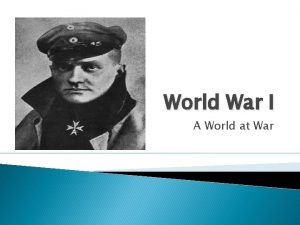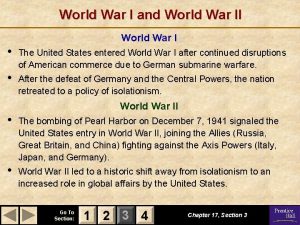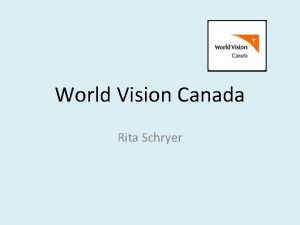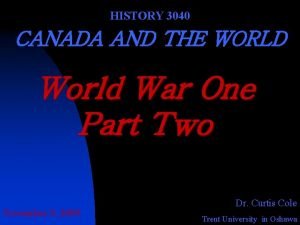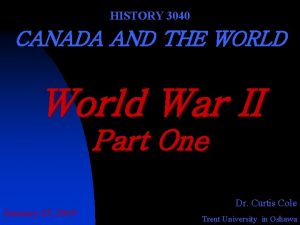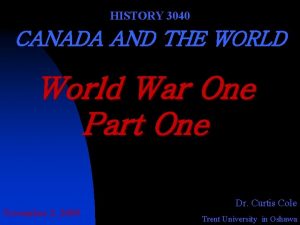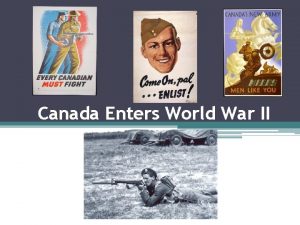Canada in World War II Canada on the

















- Slides: 17

Canada in World War II

Canada on the Home Front

Canada in the 1930 s O Sovereign but part of the British Commonwealth O Faced same challenges as the United States – no exports, O O O no money, no jobs More volatile than 1914 in French-Canada than in English. Canada Anti-Immigration reinforced the Anti-Semitic views that Jewish refuges could go elsewhere Divided along linguistic and religious lines about the issues in Europe—Spanish Civil War, Italy’s invasion of Ethiopia, etc… Appealed to the League of Nations to act Clear to Canadians that war was on the horizon but approached more cautiously than in WWI realizing that in an international crisis— Canada would again fight for the empire.

Canada at war: O After the invasion of Poland, the War Measures Act prepared to call volunteers for the armed forces. O Canada’s first declaration of war was signed by King George VI on September 10, 1939 O Government took control over Canada’s international transactions O Raised taxes

Division: O Short lived burst of national unity O Challenged by Quebec & Ontario particularly over the issue of conscription O Quebec O Led by Premier Maurice Duplessis O Attacked the war and told the public Quebec would not participate O Promised no conscription O Duplessis lost reelection—liberal government who supported the war effort was brought in O Ontario O Liberal government led by a premier who hated Prime Minister Mackenzie King O King courted the provinces business talent to run the war effort and gain provincial support

The Home Front: O War industries and military recruitment vacuumed O O O up the unemployment from the depression Material shortages were common so the scarce supplies they had could be diverted to the war effort Embarked on a full war production program Introduced modified conscription in June 1940 O Compulsory enlistment for home defense only and limited to the North American continent Jobs in war factories paid well so despite heavy taxation, hundreds of thousands were better off than in the 1930’s Unemployment was down to 2%

Changes in the economy & society: O Population shifted from country to the city as war industries were greatly concentrated in the large metro areas of Montreal, Toronto, Winnipeg, and Vancouver. O Diversified agriculture which fed the meat production so there was no ration for steak and money flowed to the prairies O GNP increased from 5. 621 billion to 11. 863 billion O Household income increased but shortages limited purchases allowing Canadians to save for a better day

Propaganda & the end of the war: O Not as necessary as World War I O Propaganda of the era underestimated the tragedies of the Axis Powers O “Total war”—preached sacrifice O Political stability allowed Canada to emerge richer and more stable having learned from the experience of WWI

Canada Abroad

Timeline of events: O 1937: King travelled to Berlin and told Hitler that if Germany invaded Britain, Canada would come to her aid O Sept. 10, 1939: Canada signed its first declaration of war as an independent country O Dec. 07, 1941: Canadian troops attacked in Hong Kong—troops held as POWs for the remainder of war O July 1943 -Winter 1945: helped invade Sicily O June 06, 1944: D-Day invasions O May 1945: V-E Day (Netherlands)

The Italian Campaign O 1943 -1945: O Very bloody O End of battle was indecisive O Canadian troops distinguished themselves but still far from the action

D-Day: O June 06, 1944: O Enjoyed air superiority and advantages in equipment over the Germans O Helped the British hold the Germans off until the US opened a second offensive O Lasted 9 weeks: heavy Canadian casualties O Defense Minister (Ralston) visited troops after battle, returned back to Canada, and reported that conscription was a necessity

O May 1945: V-E Day: O Canadian troops were fighting in the Netherlands when Germany surrendered so they were able to liberate Holland

America & Canada O Concerned over ending war in debt to US O Hyde Park Agreement: the US bought materials from Canada & Canada drew on American aid to Britain for supplies O A foreign exchange of goods, not a donation of money O Canada did not end the war in debt to US O Relations were conducted on a level playing field which benefited both countries

Soviet Union & Canada: O Faction of Canadian communists who tried to prevent the war when the USSR was an enemy & later became patriots of the war when USSR was under attack from Germany O Opened an embassy in Ottawa and used it to get Canadian supplies for war effort O Created an espionage network to discover what Canada and other Allies were up to during the war O Not revealed until after war

France & Canada: O Two groups of Canadian supporters in Quebec that differed on leadership in France: 1. Vichy France (Marshal Petain): ended war with Germany, promised to cleanse France of issues that allowed it to be defeated, Catholicism 2. Free France (Charles de Gaulle): located in London, condemned peace with Germany, promised to restore France by helping Allies defeat Germany

Canadian Achievements in WWII: Survived the war 2. Became richer and more stable towards the end of the war compared to beginning 3. Produced large numbers of men, munitions, and supplies 4. Placed 3 rd among Western Allies in military personnel Peak: 500, 000 army 100, 000 air force 200, 000 navy 15, 000 women 1.
 Maine vs canada war
Maine vs canada war James madison war at home
James madison war at home Vietnam war
Vietnam war The cold war begins lesson 1
The cold war begins lesson 1 Sclc and sncc venn diagram
Sclc and sncc venn diagram Why did josette dugas want to go to war
Why did josette dugas want to go to war War warst war
War warst war Contact force examples
Contact force examples Civil war first modern war
Civil war first modern war Perfect lizz
Perfect lizz Chapter 16 lesson 2 challenges to slavery
Chapter 16 lesson 2 challenges to slavery Proxy war cold war definition
Proxy war cold war definition Chapter 30 the war to end war
Chapter 30 the war to end war Chapter 30 the war to end war
Chapter 30 the war to end war Hát kết hợp bộ gõ cơ thể
Hát kết hợp bộ gõ cơ thể Ng-html
Ng-html Bổ thể
Bổ thể Tỉ lệ cơ thể trẻ em
Tỉ lệ cơ thể trẻ em
